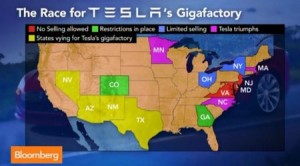 by Jon LeSage, editor and publisher, Green Auto Market
by Jon LeSage, editor and publisher, Green Auto Market
Here’s my take on the 10 most significant and interesting occurrences during the past week…….
- More details revealed on Gigafactory – Was it Col. Mustard with a dagger in the billiard room? The mystery of the Tesla “Gigafactory” is beginning to be solved. Panasonic Corp. has reached a basic agreement with Tesla Motors to supply machinery to make lithium battery cells; and an investment of about 20 billion yen to 30 billion yen ($196.4 million to $294.7 million) initially, according to the Nikkei newspaper. Details are being worked out, with an official announcement expected by the end of this month. In May, Panasonic said it wanted to be the sole battery partner in this factory. Analysts expect the factory to need about $5 billion to get up to speed, and that Panasonic may put in $1 billion of it. And while Tesla has officially looked at three sites in the US to build the plants, the decision might have already happened. Greentech Media reported that the world’s largest lithium-ion battery factory will be built near Reno, Nev. One unnamed source took pictures of about 50 earthmovers clearing a site estimated to be large enough to house the proposed 10 million-square-foot Gigafactory. This source has also heard whispers about the secret project from construction industry folks and locals. There are still permitting and licensing issues to be worked out, and Tesla says it’s potentially the site of a pizza factory…… We shall see……….
- Fisker’s new owner announced second model – Fisker Automotive may launch its second model in 2017, though no details have yet been released. Lu Guanqiu, the billionaire chairman and founder of Fisker’s owner, Wanxiang Group, Inc., thinks that this can happen in the next three years with the Karma luxury sports car returning to market well before then. The Karma will be built once again in Finland, and Wanxiang hopes to bring production to the US.
- Los Angeles will be added to Nissan’s “No Charge to Charge” promotional campaign on Aug. 15 for its Leaf electric vehicle charging program. Leaf drivers get an EZ-Charge card for public charging stations for two years. The program was launched in Dallas-Ft. Worth and Houston in Sept. 2013; since then, it’s been expanded to San Francisco, San Diego, Seattle, Nashville, Phoenix, Washington, Portland, Ore.; and Sacramento, Calif. Nissan plans to add 14 more markets in the next year.
- National Highway Traffic Safety Administration (NHTSA) is late on creating rules governing electric vehicles (EVs) making noises to warn pedestrians as EVs pass by, and automakers say they’ll need more time to adopt the rules to vehicles. That rule was supposed to be released in January, so automakers are urging a delay in the schedule that requires them to start phasing it until 2016. The Alliance of Automobile Manufacturers and Association of Global Automakers jointly issued a letter asking NHTSA to postpone full compliance until Sept. 1, 2018.
- General Motors Opel subsidiary won’t be offering the Ampera (the European version of the Chevy Volt) after the Volt is redesigned for the US market for the 2016 model year. Opel will launch its own successor, an electric vehicle, sometime between 2014 and 2018.
- Samsung isn’t just rolling out new Android smartphones – the South Korean technology supplier has expanded its partnership with BMW to produce lithium-ion battery cells for the BMW i3, BMW i8, and additional hybrid models that will come out later. That partnership started in 2009 and now Samsung has agreed to enhance developments of its battery cells.
- Natural gas vehicle supporters were unable to gain necessary support for a diesel gallon equivalent that would govern the sale and pricing of natural gas for heavy duty vehicles. NGVAmerica says that they were unable to get the votes necessary to move it forward at the National Conference on Weights and Measures in Detroit. The gasoline gallon equivalent was adopted in 1994, but the industry needs the diesel equivalent standard for realistic comparisons.
- Renewable energy saw more gains in the first half of 2014. The Federal Energy Regulatory Commission’s Office of Energy Projects reported that wind, solar, biomass, geothermal, and hydropower made up 55.7% of newly installed electricity generating capacity in the first half of this year. Natural gas provided most of the balance of new generating capacity.
- Stop-start technology yields a 5% to 7% improvement in fuel economy and C02 reduction, according to a AAA study. The AAA tested three vehicles equipped with automatic stop-start systems using the US Environmental Protection Agency’s “urban” driving cycle.
- Nissan has been able to save $938,000 per year at its Smyrna, Tenn., plant using the US Department of Energy’s (DOE’s) Superior Energy Performance program. Savings at the plant that assembles the Leaf and other Nissan vehicles comes through using the ISO 50001 energy management standard. Nissan made changes at its plant such as rescheduling work shifts, reducing motor spends in industrial hardware, and improving startup and shutdown procedures. The $331,000 investment was paid back in four months and led to annual savings; it was much less capital intensive than buying new hardware or doing expensive retrofits, according to the DOE.



